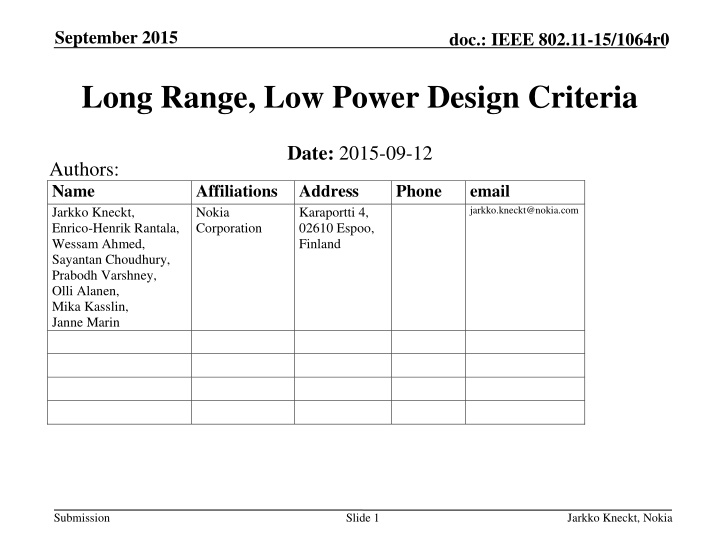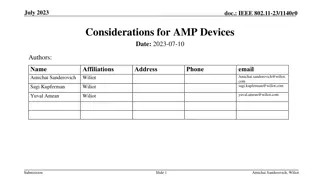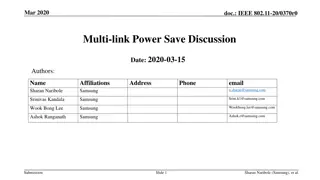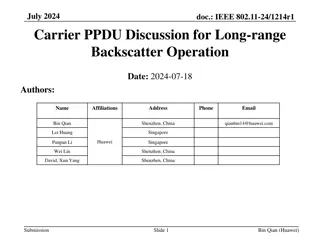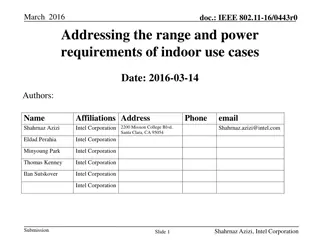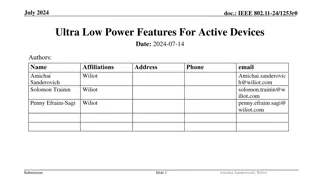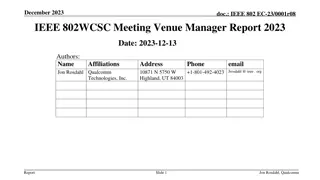IEEE 802.11-15/1064r0 Long Range, Low Power Design Criteria Study
Submission on design criteria for Long Range, Low Power (LRLP) in WLAN systems aiming to enhance transmission reliability and range while ensuring compatibility with existing WLAN networks. The key technical components include ultra-low power consumption, communication range extension, and coexistence with deployed WLAN systems. Criteria cover ultra-low power non-AP STA operation, simplicity, reliability, improved coverage, and coexistence mechanisms for sub-20MHz operation.
Download Presentation

Please find below an Image/Link to download the presentation.
The content on the website is provided AS IS for your information and personal use only. It may not be sold, licensed, or shared on other websites without obtaining consent from the author.If you encounter any issues during the download, it is possible that the publisher has removed the file from their server.
You are allowed to download the files provided on this website for personal or commercial use, subject to the condition that they are used lawfully. All files are the property of their respective owners.
The content on the website is provided AS IS for your information and personal use only. It may not be sold, licensed, or shared on other websites without obtaining consent from the author.
E N D
Presentation Transcript
September 2015 doc.: IEEE 802.11-15/1064r0 Long Range, Low Power Design Criteria Date: 2015-09-12 Authors: Name Jarkko Kneckt, Enrico-Henrik Rantala, Wessam Ahmed, Sayantan Choudhury, Prabodh Varshney, Olli Alanen, Mika Kasslin, Janne Marin Affiliations Nokia Corporation Address Karaportti 4, 02610 Espoo, Finland Phone email jarkko.kneckt@nokia.com Submission Slide 1 Jarkko Kneckt, Nokia
September 2015 doc.: IEEE 802.11-15/1064r0 Abstract The submission discusses about design criteria for the Long Range, Low Power (LRLP) [1]. Submission Slide 2 Jarkko Kneckt, Nokia
September 2015 doc.: IEEE 802.11-15/1064r0 Introduction LRLP targets to improve WLAN transmission reliability and range yet not being adverse to other WLAN systems [2] LRLP key technical components discussed in [2]: Ultra low power consumption Communication range extension Coexistence with deployed WLAN networks Submission Slide 3 Jarkko Kneckt, Nokia
September 2015 doc.: IEEE 802.11-15/1064r0 Design Criteria for LRLP Ultra low power non-AP STA Operate with small size batteries (e.g. coin cell) Simplicity Light-weight non-AP STA protocol Power consumption and complexity burden carried by AP Enables simple non-AP STAs Reliability Improved coverage edge performance Coexistence with legacy WLAN Mechanisms for Sub20MHz operation Submission Slide 4 Jarkko Kneckt, Nokia
September 2015 doc.: IEEE 802.11-15/1064r0 Ultra Low Power for LRLP Non-AP STA operation using sub 20MHz bandwidth Spectrum efficient MAC Non-AP STAs could be grouped in frequency and time in an efficient way exploiting OFDMA Protocol overhead (signaling, headers etc.) minimized Submission Slide 5 Jarkko Kneckt, Nokia
September 2015 doc.: IEEE 802.11-15/1064r0 Backwards compatibility considerations Non-AP STA need not to support HE/Legacy In order to keep device requirements minimal AP that supports LRLP also supports HE/Legacy Minimum requirement for AP would be the ability to protect LRLP transmissions from HE/Legacy transmissions and vice-versa Submission Slide 6 Jarkko Kneckt, Nokia
September 2015 doc.: IEEE 802.11-15/1064r0 Summary LRLP non-AP STA supports ultra low power operation LRLP AP has both HE/legacy and LRLP modes to ensure WLAN coexistence Submission Slide 7 Jarkko Kneckt, Nokia
September 2015 doc.: IEEE 802.11-15/1064r0 References [1] Agenda for LRLP September meeting https://mentor.ieee.org/802.11/dcn/15/11-15-0998-00- lrlp-september-2015-agenda.pptx [2] Integrated Long Range Low Power Operation for IoT https://mentor.ieee.org/802.11/dcn/15/11-15-0775-01- 0wng-integrated-long-range-low-power-operation.pptx Submission Slide 8 Jarkko Kneckt, Nokia
